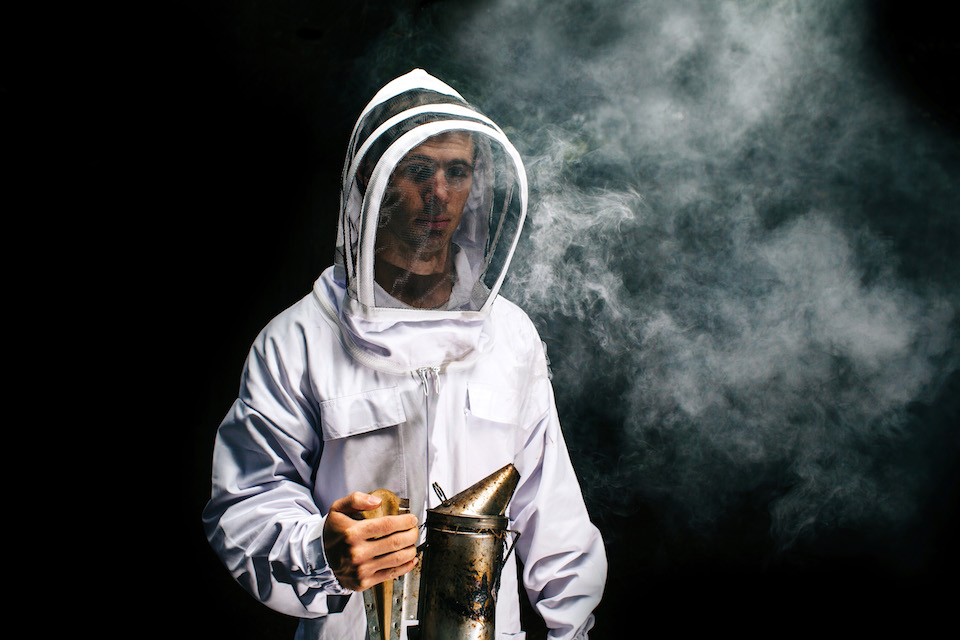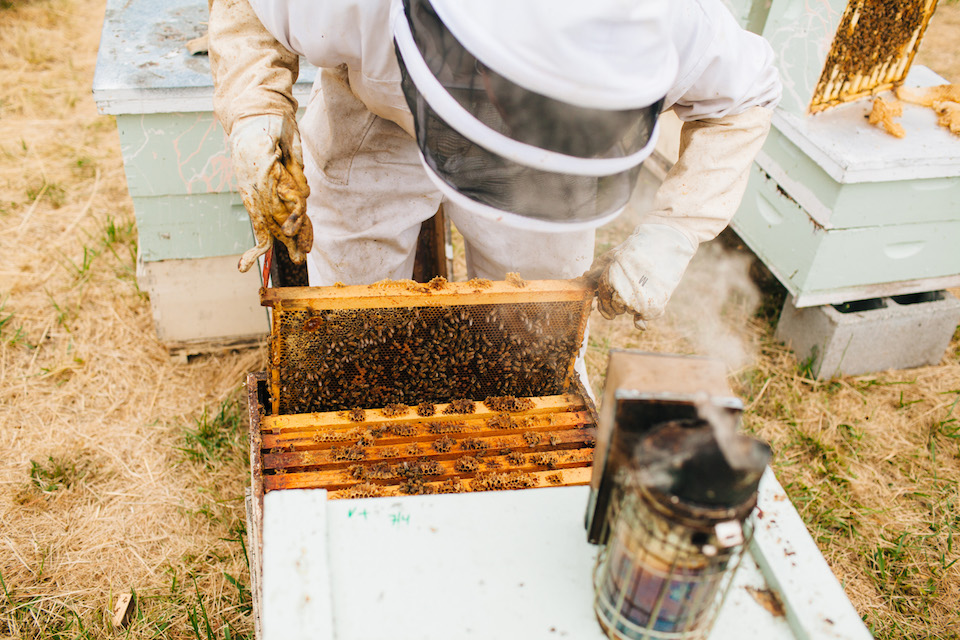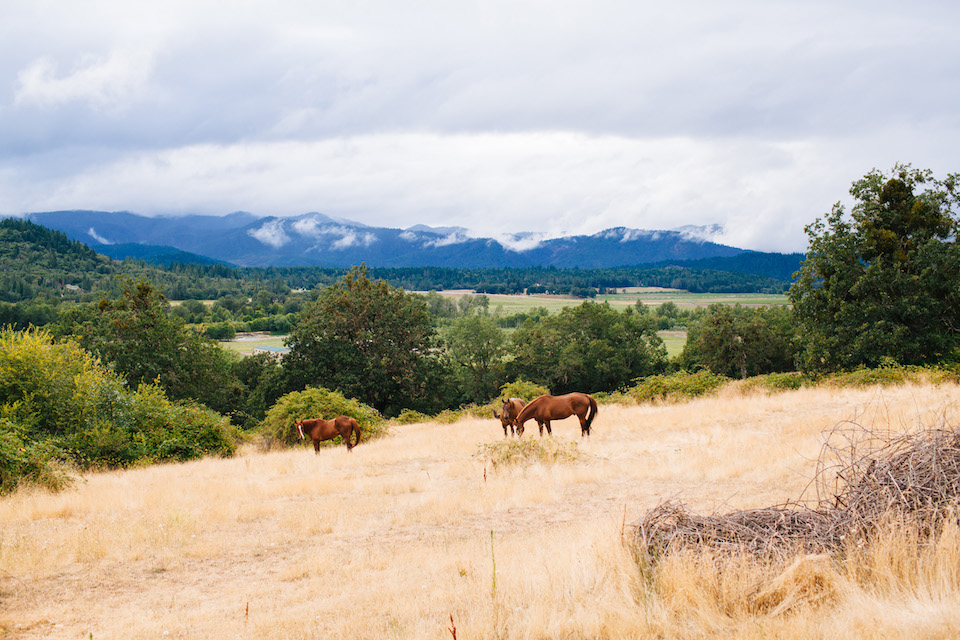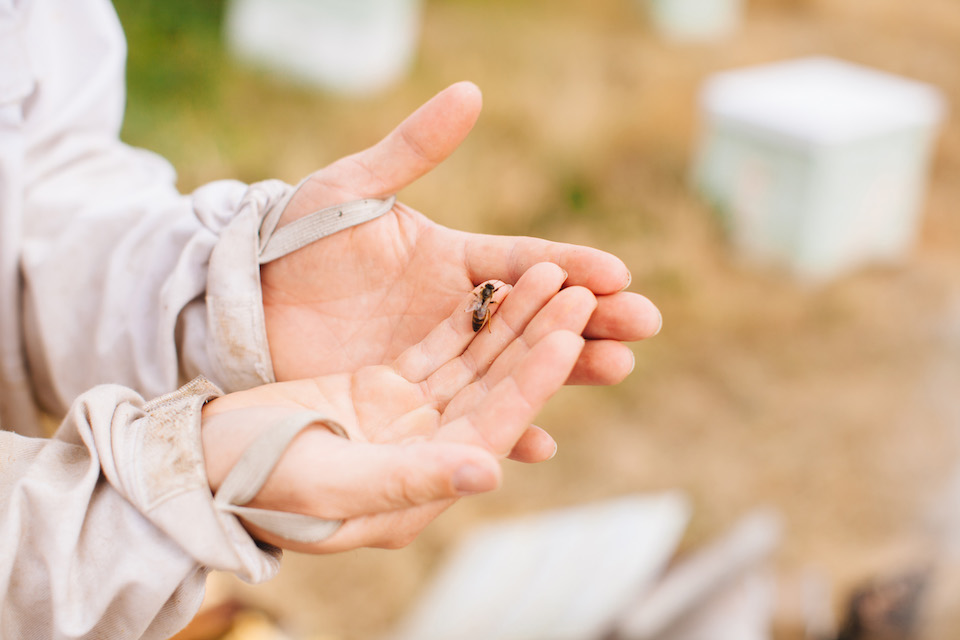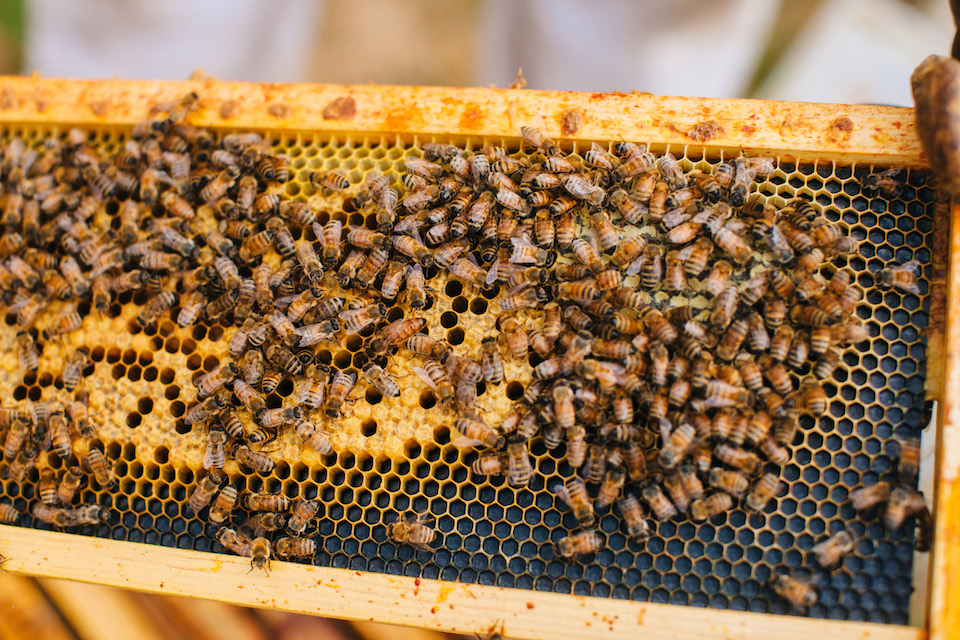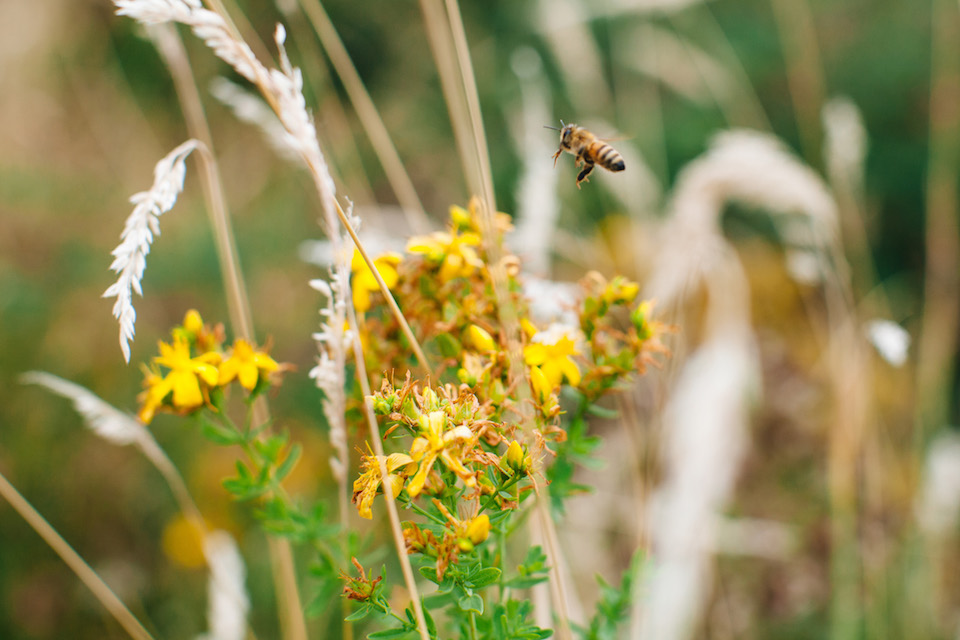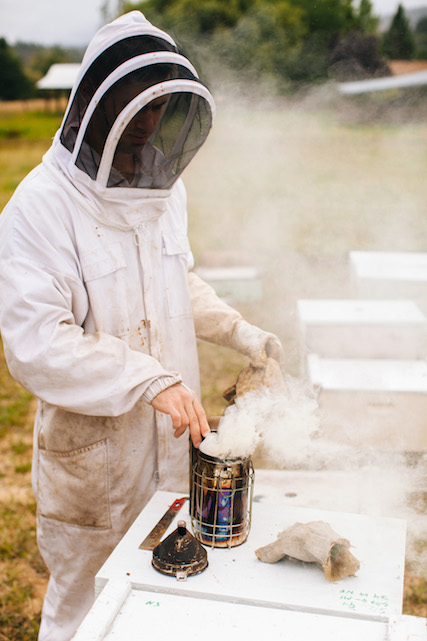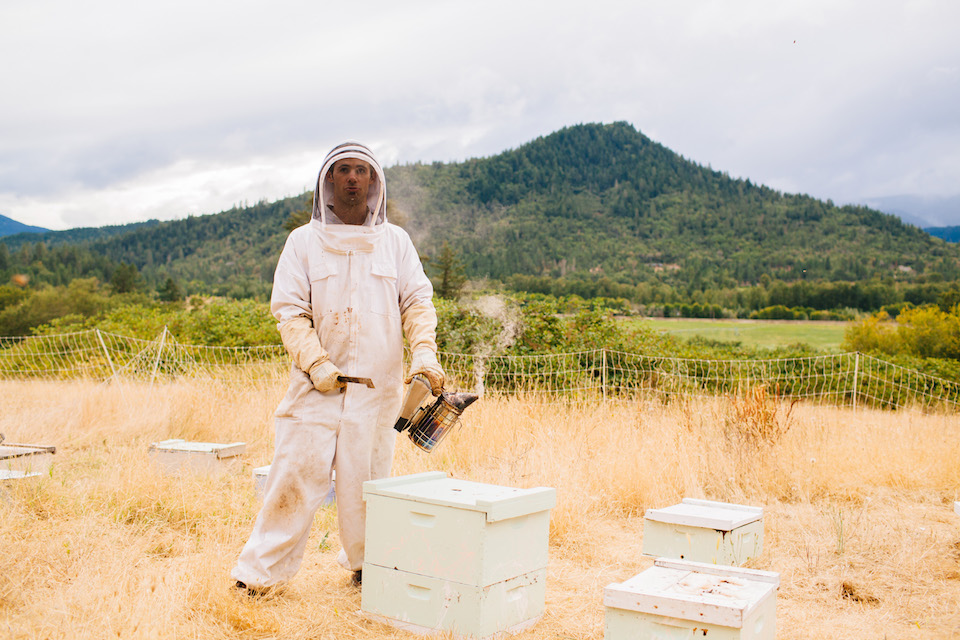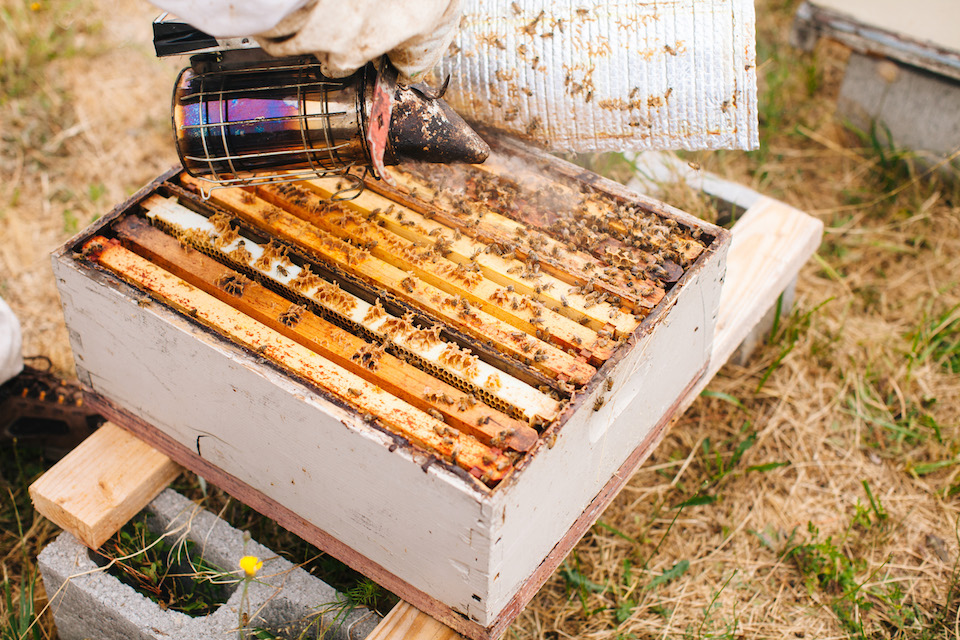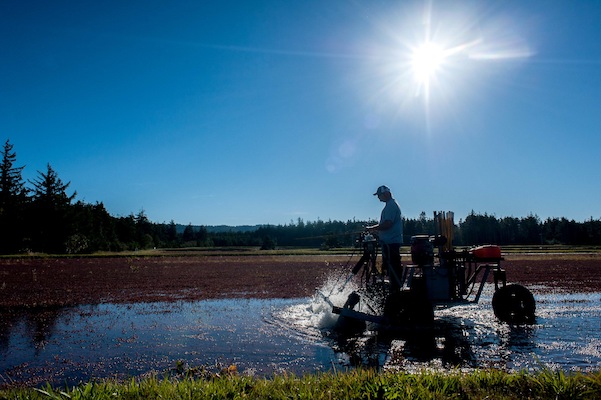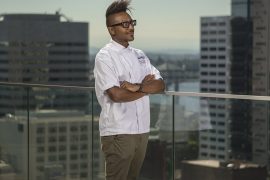written by Tricia Louvar | photos by Eugene Pavlov
“I wouldn’t stand there,” said Matt Morris, apiarist, bee educator and co-owner of Mickelberry Gardens. “The bees will get stuck in your hair. Always stand to the side of a thriving hive.”
Point taken. I quickly switched positions, since I hadn’t yet put on a borrowed bee suit and helmet with veil. “Thriving” is euphemistic for 50,000 bees inside the industry standard Langstroth beehive. The bee activity on the outside looked like an aerial view of Iowa Hawkeye fans at a stadium’s exit.
Morris, 37, tended to three of the five beehives along a hedgerow in Troutdale. He wore a T-shirt that read Honey Lover. He, along with this wife, Madelyn, started Mickelberry Gardens, which manufactures local honey herbal remedies in a 2,500-square-foot former grocery space near a busy intersection in Gresham.
Morris waved a smoker around the beehive to disorient the bees before lifting the lid. “I think many of us come together knowing the honey bees are in trouble,” he said. “We want to be proactive and help. We want to be self-sustaining.”
There’s been so much buzz about bee colony collapse of recent years that we reached out to five Oregonians with their hands in the beekeeping culture to see things from their eyes. We traveled from Grants Pass to Portland and connected the hives in between from professional pollinators to backyard hobbyists and hive business-makers.
“Leave no pollinator behind,” may be the mantra for tender conservationists in this state. Those interested in apiculture—the kind with beehive boxes, honey products and those who catch and sell swarms—dominate the ecosystem of modern-day pollinator consumerism.
Take Noah Clipp, the accidental beekeeper, of Grants Pass. Clipp told a story about how his family of nine loved honey. One day, his mother said with nonchalance that one of them should learn how to manage a beehive for the family. Intrigued and ready for the challenge, Clipp volunteered and spent the twelfth year of his life reading, researching and learning about honey bees. At age 13, he used all of his own money (a few hundred dollars) and bought his first beehive. The bees died in their first winter. He saved up more money and tried again. So goes the life of a beekeeper: hive management and hive loss.
Flash forward twelve years and Clipp is the owner of Noah’s Bees & Products. He has lost hives, sustained hives, and continues to learn as he goes and grows as a businessman and apiarist. At the beginning of the 2016 season, he managed 250 hives. Clipp sold 100 hives and worked as a nomadic apiarist and pollinator steward with the remaining hives that he placed in organic fields in the Grants Pass area.
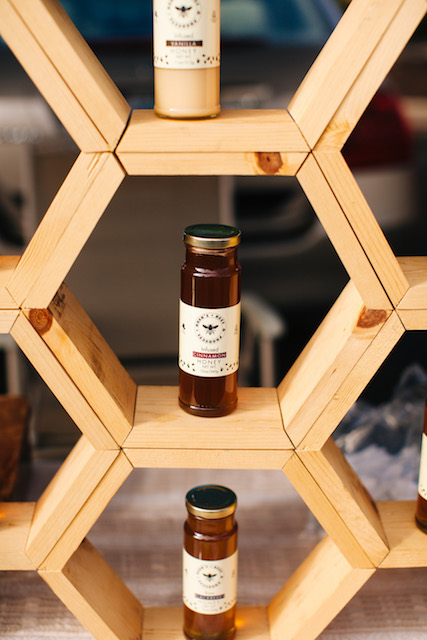
“It’s taken me all this time to become a self-sufficient beekeeper,” he said. “This is my only job now. I built my business from scratch: no loan, no trust fund. The goal for my business has been to be able to teach my kids beekeeping one day and spend time with them. Relationships are the key in this lifetime.”
Aside from beehive management, Clipp also creates and sells artisan honey products. For example, his bees pollinate blueberry patches, and he puts those blueberries back in the honey they make for an infused flavor. It’s the epitome of the cyclical, localized movement.
Like many things in Oregon, beekeeping has become a study in lifestyle and sustainability. “We do have one of the most diverse floras in the U.S.—number four on the list of most diverse, I think—which reflects the fact that we go from ocean beaches and sea cliffs to alpine, via temperate rainforests and deserts, with the Siskiyou thrown in for good measure,” said Matthew Shepherd, communications director of Xerces Society, the global invertebrate conservation organization based in Portland. “With such a diverse flora, you’d expect there to be a diverse bee fauna.”
More than 500 out of 20,000 species of bees live in Oregon. We have native bees (bumble, mason, mining, leafcutter, long-horned, etc.) and non-native (honey bees). Pollinators—which also include butterflies, moths, beetles, flies, birds and bats—are threatened to such a degree that Oregon became the first state in the nation to pass legislation to protect pollinators from neonicotinoids, insecticides that are related to nicotine.
“Six neonicotinoid products have been used—three are really bad and three are highly toxic,” said Scott Hoffman Black, executive director of Xerces Society. “The neonicotinoids are persistent, because they stay in the landscape for years. They effect aquatic life as there are traces in the water. They are bad for bugs; birds eat the bugs. The entire ecosystem is effected by pesticide use.”
In June 2014, President Barack Obama issued a memorandum to create the Pollinator Health Task Force, a nationwide attempt to increase pollinator populations and restore their habitat loss. “The legislation is a good start, but needs to go further,” said Black. “The real critical issue is not just agriculture, as it’s vital for us, but it’s really about biodiversity. The pollinators lay the foundation for all animals, from the song birds to the grizzly bears.”
Pollinators need habitat to thrive. This is good news.
Now, the not so great news.
The timber and agriculture industries topped the list of the development footprint in Oregon, according to “The Disappearing West,” a decade-long study from the Center for American Progress on human development and natural resources in the American West. The study emphasized that Oregon lost 412 square miles of natural area to development between 2001 and 2011, the duration of the research. This is equivalent to nearly 200,000 football fields of open, natural areas. The majority of the land gobble came from Washington, Clatsop and Multnomah counties.
Only ten percent of Oregon’s land is permanently protected from development, according to the “The Disappearing West.” Forty-eight percent of Oregon’s total landmass is covered by forests. “Almost sixty percent of forest land in Oregon is in federal ownership, while twenty percent is in industrial ownership, and fifteen percent is held by small private landowners. The rest is in state, tribal or other public ownership,” according to the Oregon Department of Land Conservation and Development. With development comes loss of habitat, wildlife and the scenic beauty of Oregon.
“We can’t stop progress, but we can move forward in a more thoughtful way,” Black said. “As we develop urban or suburban settings, or as we’re doing agriculture in a thoughtful way, there should be alignment with the wildlife that uses these large areas.”
Melissa Robertson of Sisters embodies Black’s sentiment but as a bee hobbyist (in waiting). Build it, and they will come, is more of Robertson’s apiarian mission statement in the high desert. “This isn’t exactly a magnet for honey bees,” she said, looking around at her homestead’s juniper forest.
She pulled her daughters’ clothes from a wicker basket and hung them on the square clothesline. Self-sustainability motivates her family. Soil is Robertson’s yoga. In her backyard acreage, she created circular irrigation and planting architectures, techniques she learned while working at Oregon State University’s experimental wheat fields on plots around the state. She keeps a Warré beehive, new and empty, at the property’s edge. “This area is perfect for the bees when they come,” she said. “It has full sun, protected from the wind. I’m planting them more food, and it has a water source.” Her pollinator water source included a bird bath filled with rocks. “The rocks are there so the bees can land, drink and not drown in the process,” she said.
Raucous chickens cackled loudly in the yard. “They get in a tizzy when someone shows up. They want to be heard, be known,” Robertson said. “I have thirty. Way too many. I need to kill ten of them.”
One thing common among Oregon beekeepers is they often keep chickens. “Chicken keeping is the gateway to beekeeping,” said Matt Reed as he strolled past a large chicken coop in a suburban Narnia, shrouded in secrecy behind rustic modern corrugated metal gateway, a few blocks away from a bustling street in Milwaukie. Reed, 33, started Bee Thinking in Portland with this wife, Jill McKenna.
Near a persimmon tree, bees bearded the front of a top bar hive. It looked like a fat beaver tail that stuck out and slid down the hive. Reed, an Alaskan with horn-rimmed eyeglasses and a light-colored summer fedora, became intrigued by bee ecology and behavior after he fed a lone bee a drip of honey in his kitchen, set it free and the next day a cluster of bees appeared on the front screen door. He researched beehive body plans that dated back to the nineteenth century. In their garage, he built top bar, Warré and Langstroth bodies. He shared them online and people from around the world clamored for his hives made of kiln-dried Western Red cedar plank.
Bee Thinking, a shop of locally made hives, beekeeping supplies and complementary bottle shop Mead Market, which sells honey wine, continues to thrive. “Our biggest concern is to provide a strong genetic pool of bees to the local community,” said McKenna, 41, who previously worked in the wine industry. “We want to use everything in the hive that it has to offer.” The couple engages with their beekeeping community to find the tried and true methods.
The now ubiquitous news of colony collapse disorder, neonicotinoid use, hive mites and toxic viruses have spurred scientists, conservationists and backyard beekeepers to foster new pathways to invigorate and change the pollinator plight, specifically of honey bees.
“Honey bees are the third most economically important agricultural livestock globally after cattle and pork,” according to a peer-reviewed article in Apidologie, a journal of bee science. “Honey bees are indispensable to the stability of crop production and food security in the USA, contributing $17 billion to crop quality and quantity via pollination services.”
Reed said that the beekeeping culture has two major hives. There is the old guard—those who have been doing beekeeping the same way for the past century. For example, Ruhl Bee Supply, beekeeper supplier and educator since 1898, continues to thrive online and in its retail space in Wilsonville. Then there is the avant garde, composed of backyard beekeepers and urbanites, who put hives anywhere (city balconies included) all in the name of local ecology and sustainability.
Oregon is home to more than 70,000 hives as of the winter 2016, according to the Oregon State University, College of Agricultural Science.
“When we think of bees, we think of honey bees but there are hundreds of bee species in Oregon,” Black said. “They live in various places. Seventy percent of nests are in holes, in snags. If we use chemicals in agriculture and urban areas and poison the animals, we won’t get very far.”

